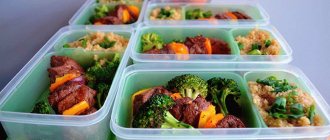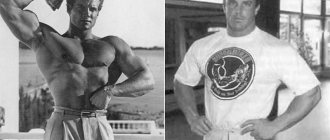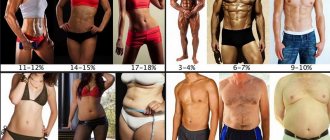FITNESS AND BODYBUILDING
Exercise, nutrition, training programs
BODYSPORTAL.COM
= 10 thousand readers
- home
- Blog
- Exercises
- Workouts at home
- Nutrition
- Programs
- Sportspit
- Trainer
- Adviсe
- Interesting
- Body-building
- Fitness

Training programs on BodySportal.com - fitness and bodybuilding, personal training ONLINE
- Exercises
- Nutrition
- Programs
- Supplements
☝ ☎ Details on WhatsApp
Body-building
- Home WorkoutsFor Weight LossPersonal TrainerNutritional SupplementsArticlesExercisesNutrition
Exercises
- NeckLower BackBellyArmsShouldersChestBackButtocksLegs
sports nutrition
- ProteinAmino acidsCarbohydratesCreatineFat burnersPre-workoutsMultivitaminsVitamins
Water
Vital during training, because dry mouth will not bring you anything good. On the contrary, it can only cause harm (dizziness, nausea), don’t be afraid, water is not high in calories, you can drink it as much as you like (of course, if it’s plain water, not Coca Cola, etc., otherwise it will already be high in calories) + water during training , enveloping joints and penetrating soft tissues, protects them from injury.
For those who have amino acids in soluble (powdered) form, they can be mixed together with water and absorbed during exercise for maximum effectiveness. (not necessary)
Conclusion: take at least 1-1.5 liters of plain still water with you.
It’s good to have it with you during training and why we’ve already discussed it. Now I present to you the preparation of a training complex, day by day and week by week.
I identified 4 training programs that I based on:
- For beginners (3-4 or 2 workouts per week)
- for intermediate level (split 3 days a week)
- for intermediate level and more experienced (split both 3 and 5 days a week)
- for experienced athletes (split 5 days a week)
Tips and fitness for the bodybuilder. Bodybuilding classes
Published: 12/23/2010 in | |
Bodybuilding exercises workouts at home
In order for the results of training to be correct, it is worth choosing the right time for them. For example, you can clearly choose three days a week. Rest assured, three days is enough to train your muscles, and the remaining four are enough to recuperate and rest. Many people mistakenly believe that the more you train, the faster an athletic body will appear, however, it is worth remembering that the muscles need to rest more than work. With the wrong approach, muscles simply will not grow.
Any workout that uses bodybuilding exercises should not exceed 2 hours, and you must have time to give your all in these two hours. At the beginning of the workout, a 10-minute warm-up is required.
By the way, maybe the fact that you picked up a heavy barbell flatters your pride, but in reality, by doing the exercises incorrectly, you are simply pushing the air. The optimal weight for you is the weight at which you can do 9-12 correct exercises (extensions and flexions) at a slow rhythm.
In addition, we advise you to train together with someone. Firstly, with paired exercises there is a good incentive to work on the muscles, and secondly, the knowledge that you will always be covered helps you concentrate on the exercises.
How to become beautiful and strong without having a gym membership? Very simple. Organizing bodybuilding at home is very easy. To do this, you need to have a bench press bench, a pair of dumbbells or a barbell. And, most importantly, a clear training program. The barbell and bench for the bench press are better than other machines that fill bodybuilding gyms.
The fact is that when doing bodybuilding exercises on a bench or with a barbell, constant monitoring is required, since they do not protect you, neither with fixing competitions, nor with grooves. Thus, with each repetition you should monitor the cleanliness and technique of the exercises. And now, with the help of these simulators, you can train not only your muscles, but also your balance and coordination.
Bodybuilding at home is a very effective method of working on yourself, sometimes even more effective than working on your body in the gym. The main thing to remember is that the more kilograms you get, the stronger you become, but the main thing here is not to overdo it and always remember about the speed of the exercises. Strength training should never come at the expense of your mobility.
For beginners (3-4 or 2 workouts per week)
Once you start bodybuilding using this training program in the gym, stick to it for at least 6 months. After which you can move on to the next training program.
The essence of this training program is as follows: we break the body into two workouts using a split. Split - translated from English. split. This means that we will split muscle groups on different days. Namely:
This is what a training split looks like:
- Day 1 – Legs, back.
- Day 2 – Chest, shoulders, arms.
After each such workout in the gym, we rest the next day. If you are not young or have a very stressful job, you can safely take two days of rest instead of one.
Therefore, in a week we will have either 3-4 or 2 workouts in the gym.
It will look something like this:
- Day 1. Monday - Legs, back
- Day 2. Tuesday - Rest
- Day 3. Wednesday - Chest, shoulders, arms
- Day 4. Thursday - Rest
- Day 5. Friday – Legs, back
- Day 6. Saturday - rest
- Day 7. Sunday - Chest, shoulders, arms
Etc. Did you get the point? For those who have a nervous job, constant stressful situations, poor nutrition, if you are already aged, etc. and so on. feel free to add two days of rest instead of one.
It will look like this:
- Day 1. Monday - Legs, back
- Day 2. Tuesday – Rest
- Day 3. Wednesday - rest
- Day 4. Thursday - Chest, shoulders, arms
- Etc.
Program and selection of exercises:
Legs-back
- Seated leg extension 4xMAX (to warm up the knee joints)
- Squats 1-2x10-15 (warm-up) + 3x8-12 (working sets)
- Leg press 1-2x8-10 (warm-up) + 3x8-12 (working)
- Pull-ups (if you can) or chin pull-downs 4x8-12
- Bent-over barbell row 4X8-12
Chest-shoulders-arms
- Bench press on an incline bench 1-2x10-15 (warm-up) + 3x8-12 (working)
- Incline Dumbbell Press 4x8-12
- Barbell press, standing from the chest 1-2x10-15 (warm-up) + 3x8-12 (working)
- Lifting the barbell for biceps 1x10-15 (warm-up) + 4x8-12 (working)
- Bars 4x6-12
What to dream about in the gym or while working out at home
In the gym or at home, when people exercise, they most often tell themselves and others that they are doing it only to maintain their health. At the same time, they continue to smoke and drink alcohol. There is no need to talk about nutrition at all, since in this case we are not talking about any diet. There is a solid excuse - playing sports and a reference to the saying that whoever does not smoke or drink will die healthy. To which you can answer with lines from Vysotsky’s song, “It’s better than vodka and colds.” But this is by the way.
A bodybuilding training program for beginners should be built on the fact that you need to decide once and for all what you expect from your efforts in this sport. If you came to the gym just out of curiosity to try, then we can’t help you with anything, let alone advice. But if you are ready to completely change your life and subordinate it to creating a harmonious body and prolonging your life, then this is for us.
First, prepare yourself for the fact that there will be no quick results. Hard work to the point of exhaustion and a constant diet await you. Are you ready to record your results every day and keep a diary of what you ate and when? And yet, you will have to experiment on yourself and see what comes out of it. Those over 35, those over 40 and those over 50 have a familiar way of life and it is very difficult for them to change it. If you decide to do this, or even better, if you comply with all the requirements of sports existence for a long time, then this is a feat.
For intermediate level (Split 3 days a week)
First of all, decide whether the first training program continues to work or not?
If you continue to gain strength and muscle mass, then nothing needs to be changed. This rule applies to any training scheme. As long as the set of physical exercises in the gym works, do not change it. If progress is not visible, move to the next level.
The essence of this training program is as follows: we pump the whole body in three workouts.
We train the back together with the deltoids, and the chest with the arms.
We have specially allocated a separate day for legs (this will allow for better training of the largest muscle group). We adjust the training days (Monday, Wednesday, Friday or Tuesday, Thursday, Saturday) to suit ourselves.
Stick to this program as long as you make progress, it is a very effective training system that will give you guaranteed results!
It will look something like this:
- Day 1. Monday - Legs
- Day 2. Tuesday - Rest
- Day 3. Wednesday – Back-Deltas
- Day 4. Thursday - Rest
- Day 5. Friday – Chest, Arms
- Day 6-7. Saturday-Sunday – rest
This is what a training split looks like:
- Legs
- Delta's back
- Chest Hands
Program and selection of exercises:
Legs
- Squats 4x8-10
- Bench leg press 3x8-10
- Seated leg extension 3xMAX (finishing exercise)
- Calf raises, standing 3x8-10
Back deltoids
- Pull-ups or block rows to the chest 4x6-12
- Bent-over barbell row 4x6-12
- Horizontal thrust 3x6-12
- Barbell press, standing behind the head 3x6-12
- Pulling (barbell row to the chin, medium grip) 3x6-12
- Abduction of arms with dumbbells to the side 3x6-12
Chest-arms
- Bench press lying on an incline bench 4x6-10
- Incline Dumbbell Press 3x6-10
- Barbell curl for biceps 4x6-12
- Bars 4x6-12
- French bench press, lying 3x6-10
Calorie counting
Your goal now is to clean up your diet and establish the habit of writing down everything that goes into your body every day. We'll dive deeper into strategies for gaining or losing weight in the next level, but let's start by establishing some kind of starting point for ourselves.
First, keep a diet journal that you can use on a daily basis. This could be a section in your training diary, or a “digital assistant”, or a small notepad that you carry in your pocket.
In any case, it should have columns - when, what, calories. If you want to make your life easier later on, you can also separate columns for proteins, carbohydrates and fat.
Your next step is to start writing down everything you eat throughout the day. Look after yourself so as not to deceive yourself, if you ate a chocolate bar, write it down immediately so as not to “forget” about it later.
Most packaged foods are easy to count because the law requires that ingredients be clearly stated on the packaging. Just write down the numbers in your journal, but be careful!
Manufacturers often try to make their products appear lower in calories by using tiny portions. Recalculate calories to match your actual serving size. It seems to me that anyone who honestly believes that there are only two servings in a half liter of juice is a strange person.
To count calories in unpackaged foods, such as fruits and home-cooked foods, buy a calorie counting book that gives approximate information based on the weight or volume of the food. Choose a book that takes into account the protein, fat, and carbohydrate content of different types of food.
Keeping track of your eating habits will help you resist the urge to eat unhealthy foods, simply because you are now forced to face the reality of how many calories each meal adds. Ignorance may indeed be bliss, but ignorance will not help you get a great body.
To continue to improve your diet, follow the basic recommendations outlined earlier in this section. Simply put, clean up your diet and establish new, healthy eating habits to prepare for a more advanced level. We present to your attention a clear diet plan for those who are active in the gym and want to build muscles.
For intermediate level and more experienced (Split 3 or 5 days a week is suitable)
The essence of this training program is as follows: we train one muscle group during training, the intensity of the training increases, because we have more strength, and we can fully work on a specific target muscle more thoroughly.
This is what a training split looks like:
- Mon. Breast
- Tue Back
- Wed. Legs
- Thurs. Shoulders
- Fri. Hands
Program and selection of exercises
Mon. Breast
- Bench press on an incline bench (30 degrees no more) 4x6-12 reps
- Incline dumbbell press (30 degrees) 4x6-12 reps
- Bench press on a horizontal bench 4x6-12 reps
Tue Back
- Pull-ups or pull-downs (for those who cannot do pull-ups) 4x6-12 reps
- Bent-over barbell rows 4x6-12 reps
- Horizontal block row 4x6-12 reps
- Lever row 4x6-12 reps
Wed. Legs
- Squats with a barbell on the shoulders 4x6-12
- Leg press 4x6-12
- Seated leg extension 4x6-12
- Lying leg curl 4x6-12
- Calves, standing in the simulator 4x15-20
- Calves sitting in the 4x15-20 machine
Thurs. Shoulders
- Barbell row to the chin with a medium grip (broach) 4x6-12
- Barbell press, standing from the chest 4x6-12
- Dumbbell raises to the side (swings) 4x10-15
- Swings, standing (3 approaches of a drop set, first heavy, medium, light all for 6-15 repetitions, rest 20 seconds)
Drop sets are sets where you drop weight. For example, take 12 kg for 6-15 reps, immediately take 10 kg for 6-15 reps, immediately do 8 kg for 6-15 reps, and do 3 sets of these with a rest of 20 seconds.
Fri. Hands
- Barbell curl for biceps 4x6-12
- Bars (emphasis on triceps) 4x6-12
- Hammers with dumbbells 4x6-12
- Close grip barbell press 4x6-12
How to pump up at home without exercise equipment
A gym is necessary for those who decide to seriously engage in bodybuilding and build muscle mass. This is the most effective training, and the added benefit is that you can always communicate with other enthusiasts or learn from practical experience. But if you have no choice and have to work out at home, here is a short list of useful exercises.
Squats
80% of success in building a beautiful body depends on this type of training.
- Place your feet slightly wider than shoulder width; the toes are slightly turned outward, the back is straight, the chest is forward, and the buttocks are back.
- When squatting, move your knees to the sides parallel to your toes, no more.
- You can straighten your arms for balance.
There are also squats with a wide leg position, on one leg, with dumbbells.
Push ups
The pectoral muscles, shoulder girdle, back, and triceps are pumped.
Hands are spaced slightly wider than shoulders, fingers pointing forward, toes pointing to the floor. Get down low until your chest touches the ground
It is important to monitor your breathing
Widely spaced arms will increase the load on the pectoral muscle, while close placement will put more stress on the triceps.
Did you know? The world's largest biceps has a girth of 77.8 cm and belongs to the American Denis Cester.
Reverse push-ups
Thanks to this exercise you will get beautiful relief on your arms.
- Take a chair, armchair or table for support and lean on it with outstretched arms at a distance wider than your shoulders, palms facing your back.
- Feet rest on the floor.
- As you inhale, the elbows bend and the pelvis moves down, but the buttocks do not touch the floor.
- As you exhale, straighten your arms to the starting position.
Lunges
Great exercise, works even without dumbbells.
- Start in a standing position with your hands on your waist.
- Then one leg bends at the knee 90° and goes as far forward as possible, and the second, also bent at the knee, remains parallel to the floor.
- The knee does not touch the ground.
- Your back and shoulders should remain straight and your hips should move downward, not forward.
- Don't swing your body, catch your balance and keep your back straight.
Plank
The plank very well tightens all the muscles of the body, pumps the back and buttocks. This exercise is the basis of any effective workout.
- The starting position is also the main one: arms bent at the elbows and toes resting on the floor.
- The body forms a straight line, the spine is straight, the shoulder blades are slightly retracted, the stomach must be pulled in, and the buttocks must be “tucked up.”
If you hold this position for at least a minute, this is an excellent result!
Read more about the types of planks and the technique of correctly performing this exercise.
"Superman"
The name of the exercise speaks for itself:
- Lie face down on the floor with your arms straight out in front of you.
- Then lift your legs, head and arms off the floor and imagine that you want to fly up.
- Hold your body this way for a few seconds, then lower yourself.
Burpee
This is a unique way to do jumping push-ups.
- From a standing position, get into a push-up position, push up, rise back up and jump, straightening your arms above your head.
- The exercise is done quite quickly, and many muscles are involved, including the lumbar.
The main thing is not to bend your lower back too much, otherwise injury may occur.
Circuit training
In the fight against fat deposits, circuit training is considered very effective, making the body slimmer. The exercises follow one after another with high intensity in one approach. This includes strength or cardio training, the session is divided into circles of 3-6 exercises with minimal rest intervals or no rest at all. Beginners are limited to one circle, then the number of circles can be as large as you can handle.
To familiarize yourself with the technique, it is recommended to choose from the following set of exercises:
- twisting (using a fitball);
- lunges without weights;
- pulling your knees to your chest on a fitball;
- bike;
- single leg deadlift.
Do 15–20 repetitions and alternate exercises as you feel comfortable.
An example of a circuit training for home. A program using weights looks like this:
- split squats;
- single leg deadlift;
- one-arm dumbbell row;
- lifting dumbbells forward;
- swing dumbbells while standing.
To summarize, let's say that for those who are seriously interested in bodybuilding, there are many training options. You can choose the pace and loads that will be optimal. The main thing is to study the structure of the body and understand the processes occurring with your muscles. Also, when creating a training schedule, do not forget about the basic principles of nutrition.
Explanations for all training programs
- We use smart 2, 3, 5-day splits that do not cause conflicts in the recovery process.
- We use macro-overloading (gradually increasing the weights at each workout and working in the planned number of repetitions without breaking the schedule - we do not take heavier weights than planned).
- We keep a training diary, thanks to which we use both methods of load progression (1st method of repetition, 2nd method of increasing weights).
- We use basic exercises (these are exercises that involve several muscles or muscle groups; in short, these are heavy exercises that are performed with free weights). Why? The more muscles involved in the work, the better for the overall development of muscle mass.
- We use the golden mean, namely 3-4 working approaches, after 2 warm-up approaches (these approaches include a warm-up + a leading approach, where the warm-up is an empty bar, then add weight (50-60% of the working weight) in the range of 12-15 repetitions. Then add more weight and do a lead-in approach (already 70-80% of the working set) for 8-10 reps. And only then perform working approaches (100%).
- Each exercise performs 6-12 repetitions. The only exception is the calf muscles (shin) where we perform 15-20 repetitions. Why? The fact is that muscle failure should occur within 10-30 seconds. During this time interval you will have time to perform no more than 6-12 repetitions. But in the case of the calf muscles (lower leg), because... there the amplitude is very short, then where we managed to do 6-12 repetitions during this time, here we will have time to do 15-20 repetitions during this time. That's the whole secret to increasing the number of repetitions for the lower leg.
- If we use FAILURE (that is, the last repetition is a failure), you are no longer able to complete the last repetition of the exercise with the correct technique. Important: failure should occur within 10-30 seconds (6-12 repetitions).
Supplements
Sports nutritional supplements can help you in your efforts. Proper use of supplements will not only provide you with all the necessary substances, but will also give you additional strength, speed of recovery and prevent injuries.
However, sorting through what seems like an endless list of supplements seems like an impossible task for experienced bodybuilders and downright daunting for newbies.
What works? What is just a bubble and marketing nonsense? And once you figure out what really works, which brand should you choose? Take advantage of a great deal from a company you've never heard of and risk disappointment, or choose a major brand and end up broke?
These are all serious questions and we will deal with them over time, but let's start simple. If you are a beginner, there are two supplements you should definitely have. In an ideal world, you wouldn't need this either, but in reality it's hard to get everything you can from food alone.
I'm talking about the two main bodybuilding supplements: multivitamin/mineral tablets and extra protein.
Multivitamins/Minerals
This is the most basic and most important supplement in your arsenal. In order for your body to function optimally, it needs vitamins and minerals, and if you don't spend a lot of time planning and preparing every meal of the day, making sure that no nutrients are destroyed in the cooking process, you need to take supplements.
It is important to find a supplement that has almost all of the vital minerals and vitamins in the recommended daily dose
It's not much fun, but if you are forced to choose only ONE supplement, then this should be your choice. Multivitamins/minerals can come in the form of syrup, tablets, capsules, or even a combination of tablets and capsules. The choice of supplement form is yours, but be careful with hard tablets.
Some tablets are so hard that they do not dissolve completely in the stomach and never provide 100% of the possible benefits. It makes sense to test hard tablets by soaking them in a warm (but not hot) vinegar solution for 30 minutes or so. If the tablet has dissolved or at least softened, it will be fine, but if it is still rock hard, you have probably purchased a counterfeit.
There are hundreds, if not thousands, of brands offering multivitamins/minerals. Choose a reasonable price from a reputable company. It is also important to find a supplement that contains all or almost all of the essential minerals and vitamins in the recommended daily dose.
You will find that manufacturers vary slightly in the composition of their products, but don't worry if you find a composition that is close to your mineral and vitamin needs. Take your multivitamin/mineral with breakfast to make sure you don't forget about it.
Protein supplements
The main purpose of consuming protein supplements is to provide your muscles with additional “building material”. As mentioned earlier, muscle tissue needs protein in order for it to repair and grow, so your diet must meet this increased protein requirement. However, it is often difficult to get enough protein from regular meals throughout the day.
This is where supplement protein comes into the picture. The most common form of protein supplement is a simple powder that you mix with milk or water in a mixer or blender, but you can also buy pre-made drinks and protein-rich sports bars (not to be confused with sugar-laden energy bars). You can even buy protein-fortified pasta and other foods. For now we will discuss regular powder.
There are three main types of protein powder, although the lines between them have blurred in recent years. Here are the basic formulas:
- Gainers:
powders high in high-quality protein and carbohydrates. Very high in calories and suitable for naturally thin people who have problems gaining weight. - Meal replacement drinks:
A relatively balanced combination of protein and carbohydrates with a moderate amount of calories. A convenient product for those who need to eat, but don't have time to prepare a real meal. - Pure protein drinks:
These have little or no carbohydrates and are made entirely of protein. Low calorie content; serving can contain 40 grams of protein and 200 calories or less, so it's a great choice for stockier people who don't want to add calories but still get the protein they need.
If you are thin and cannot get enough calories from regular food, buy a weight gainer and try to consume as much of it as possible between meals. As the name suggests, meal replacement drinks are great if you're constantly on the go and don't have time to prepare a real meal.
Last but not least, pure protein drinks can be consumed as a snack, to boost the protein content of your breakfast, or right before bed to help your body grow.
No matter what type of protein drink you buy, don't get into the habit of skipping meals and drinking a protein drink instead. Supplements are just that: supplements; Your main source of nutrition should be healthy, good quality food!
Your actions before training
1) Open your training diary and see previous results for that week.
Then write down:
- Day of the week (for example, Monday)
- Muscle group (for example, chest)
- Number (for example, 07/1/2013)
- Working weight, sets, repetitions (for example, 50kg x 10 times x 4 sets).
In the last point, it is important to progress (look at the previous results for that week in order to know how much to increase the load now. All this is done in order to control the progression of the load using a diary (see below how to keep it).
Bodybuilding Basics: Recovering Strength After Training
Proper rest and recuperation after training are necessary for all athletes who engage in such a difficult sport as bodybuilding. And any disregard for the rules leads to consequences such as overtraining . Remember this, because it entails undesirable symptoms for an athlete: fatigue, stagnation of strength, loss of strength, as a result of which you mark time, not getting the desired result. Don't overwork yourself, remember: rest is also part of the workout, during which your body builds muscle.
How to keep a training diary
I think this method is the most convenient and understandable, but you can use other methods that are convenient for you (the main thing is that you understand the essence).
On the first Monday, I wrote out all the exercises, weights, repetitions, approaches. So that you understand, below is a clear example of how easy it is to do it (but I also added - here we use the 1st method, there is no need to write this, this is for you to understand).
Monday: breasts (07/1/2013)
- Incline Bench Press 50kg x 6 reps x 4 sets
- Incline Dumbbell Press 16kg x 6 reps x 4 sets
- Barbell bench press 50kg x 6 reps x 4 sets
Next Monday: chest (07/8/2013) – here we use the 1st progression method
- 50kg x 10 x 4
- 16kg x 10 x 4
- 50kg x 10 x 4
Next Monday: chest (07/15/2013) - here we use the 1st progression method
- 50 kg x 12 x 4
- 16 kg x 12 x 4
- 50 kg x 12 x 4
Next Monday: chest (07/22/2013) - here we are already using the 2nd progression method
- 53 kg x 6 x 4
- 18 kg x 6 x 4
- 53 kg x 6 x 4
2) Do a good warm-up. Warm up without weights. For 5 minutes, until your forehead is covered with sweat. Rotate your body, swing your arms up and down, left and right, jump rope...
This is where your imagination comes into play.
The purpose of the warm-up is to warm up the body, muscles, ligaments and joints and prepare the body for strength work.
Then proceed to the exercise, for example, bench press, perform with light weights (50-60% of the working weight) in the range of 12-15 repetitions.
Then add more weight and do a lead-up approach (already 70-80% of the working set) for 8-10 repetitions.
And only then perform working approaches (100%). All these warm-up and lead-up approaches are done in order to warm up and prepare the muscles for heavy strength work.
In the following exercises, the warm-up is no longer so important, you need to look at how you feel (for the psyche, you can also do a warm-up).
3) After each workout it is important to do a cool-down
Cool down - performed at the end of the workout.
It consists of calming exercises to calm the cardiovascular system, reduce the risk of blood stagnation in the muscles, prevent muscle pain, return contracted muscles to normal, lower body temperature to normal, etc. You can just lie down and relax.
4) Immediately after training after you enter the locker room, it is important to eat simple carbohydrates + fast proteins
At this time, the protein-carbohydrate window opens, and nutrients are absorbed many times better and faster. But remember, you can eat a full meal only after 30-40 minutes after training, so we eat fast carbohydrates + fast proteins.
For example:
- Simple carbohydrates (any sweet: chocolate, Snickers, gingerbread, banana, sweet juice)
- Fast proteins (Whey protein or amino acids, gainer, or regular boiled eggs).
Combined with proper nutrition, this training regimen will help you achieve fantastic results, believe me, I know what I'm talking about.
Okay, at this point, I gave you three training complexes (2, 3 and 5-day splits), told you about the features and explanations for all schemes, and gave step-by-step actions.
I took away the last set of exercises from these three, because it is radically different from those training programs. You will find out why by studying it!
Now I will share some bodybuilding tricks, namely, I will tell you about the fascia training system, “Fascia Stretch Training-Seven (FST-7).” Famous bodybuilders such as Jay Cutler, Phil Heath and others train using this system.
Fascia is a connective tissue membrane that covers organs, vessels, nerves and forms cases for muscles in vertebrates and humans; performs supporting and trophic functions.
When training the fascia, our main goal is to deliver as many vitamins, minerals, amino acids, oxygen, etc. as possible. into the muscle, as well as stretching the fascia that surrounds it - this allows you to achieve maximum muscle growth.
Fascia is a limiting factor in muscle growth, because the muscle grows only as long as there is free space. By training them in 7 sets in a pump style, we can stretch the fascia and thereby make room for muscle growth.
There are 3 types of fascia in the human body, but bodybuilders should only pay attention to one of them - the deep fascia. It is dense fibrous connective tissue that surrounds the muscles, bones, nerves, and blood vessels of the body.
The high density of this collagen fiber provides the deep fascia with its strength and integrity. Its expandability and elasticity are determined by the number of fibers. In other words, some of us have fascia that is thicker and more rigid than others.
Genetically gifted bodybuilders have thin fascia, so their muscles look larger and more puffy, classic examples being Ronnie Coleman and Phil Heath - these are people with thin fascia. Their muscles expand more easily.
But, for example, Jay Cutler has thick fascia. But as you can see, this did not stop him from gaining more muscle mass, but his muscles look kind of round.
The right attitude
Work, family obligations, and plain old laziness are the pieces of life that will keep you away from your scheduled gym sessions. Don't get me wrong, your kids' school play is important, but there's a big difference between the rare exception and constantly skipping practice when the gym falls down your list of priorities.
As has been said many times, focus and consistency are extremely important in the bodybuilding process, so I will share with you a few tips on how to properly tune your mind.
Your first step is to define your long-term goal as specifically as possible. “Being fit” is not a clear enough goal. What exactly do you need? Gain weight in the form of quality muscles? Get rid of fat? Exactly how much more or less is a kilogram? Increase your strength? In that case, how much?
You need to establish exactly what level you want to reach and how you will measure success. Be realistic about how long it will take you and write it down as a target date. If you're a beginner, this may be difficult to estimate, but try to anticipate and leave some slack for the estimated time frame.
Once you have determined the goal and time frame, set a few milestones, such as once a month, as milestones. This helps make the end goal less daunting, since increasing the load by 5 kg each month is quite realistic, while increasing the load by 40 kg by April may seem illusory and discouraging. For added motivation, you can give yourself a small reward each time you achieve your goal.
Concentration and consistency are important conditions for success in bodybuilding
Another important part of having the right attitude is positive thinking. Of course, it has become a cliché, but that doesn't make it any less true. If you start a diet and think you won't lose a kilo, what do you think will happen? Most likely, within a week you will be eating pizza and washing it down with beer. Fortunately, this also works in the opposite direction.
Arnold was an extremely successful athlete not only because of his grueling daily training, but also because he strived to win. In his mind he was already winning before he stepped on stage, and as history shows, that is exactly what happened time after time. You can use this technique to ensure that your daily life matches your plans.
At the beginning of each day, close your eyes and think about how you want to live it. One by one, imagine your healthy meals (picture yourself skipping donuts at a meeting), how you go to the gym, what you will do during your workout and how you will feel, and end with how you will go to bed on time .
The more details there are, the better. Repeat this exercise whenever you are tempted to put off your workout or otherwise deviate from your plan.
How to train fascia?
You should train with heavy weights using basic exercises, generally as usual within 6-12 repetitions, when you have completed the planned number of exercises for a specific target muscle group, you must perform the last exercise at the end of the workout (usually in machines where isolating load) in 7 sets of 12-15 repetitions, rest between sets is minimal (no more than 30 seconds, this is the only way we will get the maximum possible pump (this will be fascia training).
The last exercise in 7 approaches is performed at the end of the workout with the same weight; as a rule, we reduce the weight by 30%.
For example, if you perform 70 kg on the bench press, then 70 * 30:100 = 21 kg. This means that the last exercise (fascia training in 7 sets will be performed with 21 kg).
It is vital to drink as much water as possible during training. At least 1.5 liters, depending on your personal characteristics (sweating), season and your weight. In summer you need more water.
What categories are there in Men's Physicist?
The variety of IFBB categories and their presence in the rating scale depend on the number of applicants who want to take part in the competition. Today there are the following categories:
- Juniors are divided according to the following indicators: up to 1.7 m, up to 1.75 m and above, absolute championship;
- Men (Arnold, Classic, Amateur) up to the following indicators: 1.72 m, 1.75 m, 1.78 m, 1.81 m, 1.84 m and above, absolute championship;
- Men (World Championship, European Championship) up to the following indicators: 1.7 m, 1.74 m, 1.78 m and above, absolute championship;
- Male masters who are over 40 years old are an absolute category.
Additional categories, if there is a need, are introduced by the organizers after notification and discussion of this nuance with the founders of the IFBB.
In international competitions, competitions are held in 6 categories. They involve professional athletes with aesthetic bodies without huge biceps, ball-shaped shoulders and a bulging torso. 11 judges of the 1st category want to see applicants with muscular, tanned bodies and proportionally pumped up figures. This refers to the balance of the volumes of the neck, chest, shoulders and waist.
The athlete is obliged to show the body in motion, plasticity, artistry, confidence, and ability to stay on stage. Mandatory poses are specified in the IFBB protocol. After the first stage, the 15 strongest competitors are selected. Only 6 people advance to the semi-finals, from which the 5 strongest are formed.
Beach bodybuilding at the international level and in Russia have some differences in the competitive program. International competitions are held in six different categories. The classification is based on the height of the athletes: up to 168, up to 171, up to 174, up to 178, up to 181 and above 184 centimeters. The domestic competition program divides performers not only by height, but also by weight.
Russian Men's Physique competitions include the following categories based on height and body weight:
- up to 170 centimeters with a maximum weight of up to 70 kg, that is, “height” - “weight”;
- up to 174 centimeters with a maximum weight of up to 76 kg, that is, “height” – “weight” “2 kg”;
- up to 178 centimeters with a maximum weight of up to 81 kg, that is, “height” - “weight” “3 kg”;
- from 178 centimeters with a maximum weight of 83, that is, “height” - “weight” “4 kg”;
- from 190 centimeters with a maximum weight of 97, that is, “height” - “weight” “5 kg”.
The weight calculated by the formula is considered the maximum. Those whose weight is less than the maximum can also perform.
Athletes compete without shoes and in shorts that reach mid-knee, called boardshorts. Only special makeup is allowed, that is, only that which is officially permitted. There are no restrictions on wearing jewelry or accessories.
What exercises are best for the 7 sets of fascia training?
Basic compound exercises such as deadlifts, squats, etc. - a bad choice for two reasons:
- They involve other muscles and prevent them from giving full load to the target muscle
- Good technique and balance are required, which deteriorate when you try to complete a large number of sets in a short time.
The best choice is on simulators (because there is an insulating load), which is what interests us.
Security Recommendations
If you're a beginner, your goal is to learn how to lift correctly, not a lot. In addition to performing the basic exercises correctly, there are some safety guidelines you should follow to reduce your risk of injury now and in the future.
Hire a personal trainer or work out regularly with a friend so they can monitor whether you are putting yourself at risk of injury. There are several benefits - someone who knows you can understand when you do or don't need a helping hand, and last but not least, you don't have to go to the first person you come across who may have attention span issues.
Avoid overstraining your joints like the plague. Achieving a full range of motion during an exercise is correct, but overloading a joint beyond its natural capabilities is asking for trouble. In most cases, this is not even a conscious action.
A classic example is the lying leg curl. We constantly see people who sit for just a couple of seconds after completing a set of exercises. Their thigh muscles are on fire, so they relax the muscles, take a few breaths and stand up. No harm done here, right? Wrong, the whole exercise puts a huge load on the knee joints with virtually no muscle support.
Exercise regularly with a friend so they can monitor whether you are putting yourself at risk of injury
Of course, it doesn't cause any direct pain, so people don't consider it a problem until the day they get to such a weight that something in the body breaks down. That's when the pain is more than enough. This applies to the elbows, wrists, shoulders and almost all joints.
If you perform calf presses on a classic leg press machine, always use the safety stop. They won't interfere with your calf work, but if your foot slips off the plate, you'll be pretty glad you did. Otherwise, several heavy discs with sharp metal edges will fall on you, and you can say goodbye to your kneecaps.
Learn to voluntarily contract your abdominal muscles and keep their middle part tense. This will help you stabilize your torso and avoid unnecessary strain on your back. Remember that staying injury-free is an important step towards long-term success. Make it a habit to always engage your abdominal muscles when curling, pressing, or lifting weights, especially during overhead exercises such as the standing press.
Be sure to use proper lifting technique (back straight, knees bent, abdominal muscles tight) when removing and putting on the discs. Just because it's not an exercise doesn't mean you can ignore safety rules when handling 20kg plates. Also monitor disk capture. If your palms are sweaty, you risk dropping discs on your feet and breaking your toes if you don't dry your palms first.
Some people like to use a “monkey” grip, which is to hold the bar without gripping it with their thumb. This is a bad idea for two reasons. When you bench press, you are forced to tilt your arm back to prevent the bar from slipping out of your hand and decapitating you.
Unfortunately, this means that the bones in your forearm and hand will rub against each other, which can become quite painful if it becomes a habit. Secondly, there is a chance that a part of the barbell, which weighs over 80 kg, will hit your front teeth. This is quite a memorable event and it will leave a deep impression.
Balanced diet
With muscle mass growth. and an increase in strength indicators, the need for food, calories, microelements, and proteins also increases. Without consuming in the required quantity, you will simply lose all the gained weight, of course, not like the “chemists”, and it will be quite easy to restore once you resume adequate nutrition.
Here are some tips for a balanced diet:
- increase protein to 2-2.5 grams/kg
- as soon as you start to feel a slight feeling of hunger, start eating
- one meal does not have to be a big dish, it can be a smoothie, yogurt with banana
- eat more vegetables and fruits, less synthetic vitamins
Increased physical stress on the body (and mental stress too) requires increased, balanced nutrition, especially when it comes to bodybuilding, where frequent and high-quality meals are the cornerstone in achieving the treasured kilograms of high-quality muscle mass.
Balanced nutrition for a bodybuilder in containers
What should be the body parameters of a mens physicist - dry numbers
The rules do not require you to have a lean figure with a minimum ratio of subcutaneous fat. In Europe and America, height is taken as a basis and classified into categories: 168-170 cm, 171-174 and above. According to Russian rules, Men's Physique takes into account height and weight:
- the body weight of guys up to 170 cm does not exceed 70 kg;
- up to 174 – 76 kg;
- up to 178 – 81 kg;
- The maximum weight of athletes is from 190 – 97 kg.
Those whose weight is below the recommended value are also allowed to compete. What parameters should athletes focus on with a height of 180-189 cm can be seen from the data:
- body weight ranges from 92-100 kg.
- biceps volume – 44-50 cm;
- pectoral muscles – 116-129 cm;
- waist – from 73–85 cm.
Despite existing standards, many participants manage to win thanks to charisma and the ability to show off their figure advantageously.
The above nomination is a kind of symbiosis of classical bodybuilding and fitness. At exhibition performances, an athlete should not amaze the audience and judges with impressive volumes and weight. The main emphasis is on “venousness”, detailing and pumping.
More on the topic: How do beachgoers train?
The body parameters of a mens physicist must meet two main criteria - the proportional ratio of shoulders and waist. In addition, there are additional “characteristics”: a pretty face, healthy skin, not skinny legs, sculpted abs.
The waist is as narrow as possible, the shoulders are as wide as possible. This is the law of proportion of mens physicists. The whole point of the nomination is aesthetics with moderate muscle volume, demonstration of ideal body parameters and proportions.
To understand what body parameters an athlete must have in order to adequately represent himself in the category, let's look at the famous athletes in this discipline.
Jeff Seid
The youngest IFBB professional. The guy was only born in 1994, but has already managed to take part in more than a dozen tournaments among beachgoers. With a height of 182 cm, Jeff weighs 92 kg - this is a competition weight. The volume of the biceps is 45 cm, the waist is 75 cm. Seid's chest is 128, and the shin is 43 cm. Both forearms are 39 cm.
Read more: What arm muscles are developed by the carpal expander - the benefits and harms of exercises for health. How to choose the right wrist expander?
Sergi Constance
Let's give an example of another famous beachgoer, fitness model and esthete Sergi Constance. Anthropometry of men's physics looks like this: the bodybuilder's height is 185 cm, which is slightly higher than Seyd's, and, accordingly, 98 kg of dry mass. Sergi's biceps reached 48.5 cm, his chest volume was 126 cm. That is, this athlete weighs over 90 kg.
Denis Gusev
To understand what body parameters an athlete must have in order to adequately represent himself in the category, let's look at the famous athletes in this discipline.
Jeff Seid
The youngest IFBB professional. The guy was only born in 1994, but has already managed to take part in more than a dozen tournaments among beachgoers. With a height of 182 cm, Jeff weighs 92 kg - this is a competition weight. The volume of the biceps is 45 cm, the waist is 75 cm. Seid's chest is 128, and the shin is 43 cm. Both forearms are 39 cm.
Sergi Constance
Let's give an example of another famous beachgoer, fitness model and esthete Sergi Constance. Anthropometry of men's physics looks like this: the bodybuilder's height is 185 cm, which is slightly higher than Seyd's, and, accordingly, 98 kg of dry mass. Sergi's biceps reached 48.5 cm, his chest volume was 126 cm. That is, this athlete weighs over 90 kg.
ABOUT THE TIME BETWEEN APPROACHES
You can often hear criticism of volume training on the grounds that it takes too much time and therefore does not work without steroids (the natural secretion of anabolic hormones is suppressed after 40-50 minutes of strength training).
Anyone who says this is not aware that a large amount of strength work can and should be packed into a short workout (up to 45 minutes).
In order for this to become possible, it is enough to simply reduce the rest between approaches. Then over a certain period of time you will perform more approaches.
Bodybuilders often rest a lot (almost like powerlifters): 2-3 minutes. This is a mistake because such a long rest allows you to better develop strength power (strength), rather than strength performance
.
Remember, resting 60 seconds between sets will do much more for muscle growth than resting 2-3 minutes because it will allow you to do more strength work per workout. Most often, the time required to complete your exercise is 15 seconds
. Some have a little more, some have a little less... According to my observations, even 45 seconds. There is more than enough rest to recover for the next approach. Of course, you will not be able to work with submaximal weights, because this requires a maximum reduction in acidification concentration and maximum restoration of energy levels. And this is possible with a long rest. BUT for working with moderately heavy weights, this rest is more than enough. I experimented on myself and will say that even 20-30 seconds is more than enough for rest.
Let's do the math. You do a set (15 seconds) and after that let you rest for another 45 seconds. As a result, our “full cycle” (approach + rest) is 60 seconds
.
What does it mean? This means that in half an hour you can do 30 working approaches!!!
Just think about it...
Let's say you do 8 repetitions in a set, then 30 approaches will give us a total of 240 working repetitions!
And this despite the fact that 100-200 repetitions per group per workout is already the level of a professional. Well, who would argue that it takes a lot of time to perform a large amount of strength work? This is all bullshit! If you came to work and not to wag your tongue, then even 30 minutes will be enough for you. Well, let you take the time to warm up. Even in heavy exercises (such as squats), rest a little more. All the same, it is not necessary to train for more than 45 minutes. And more than 60 minutes. just stupid. Especially if you are not using anabolic steroids.
Now about those same steroids. High volume regimens are often associated with anabolic steroids. They say, look, the big muscles of professionals are so big because they pump them up with a large volume of work along with the use of steroids. And this is a very big misconception.
In my latest book, “V3 Volumetric Progress,” I talk about very interesting experiments in this regard. Now I will try to summarize their essence. were conducted on amateur athletes who trained naturally according to different schemes
.
One group did only one working set of an exercise, while the other group did multiple working sets (i.e., trained in a higher-volume pattern). After a couple of months, measurements showed increases in strength and mass in both groups, BUT in the “high volume” group, this increase was significantly greater.
And not so much in strength, but in mass!!! Scientists analyzed the secretion of anabolic hormones during training and immediately after it in both groups and came to the conclusion that in the “high-volume” group this secretion was much greater
.
CONCLUSION: Several approaches to an exercise are better for increasing strength and especially mass than one approach! Those. High volume strength training regimens are better for muscle growth than low volume ones.
How to become a participant in Men's Physique competitions?
To get into the beach bodybuilding competition, you need to know when and in what place it will be held. The next step is registration, the completion time of which depends on the level of the competition:
- You can register for a regional event, held in a small city or at the regional level, on the same day it begins.
- For a regional one, if we are talking about a large populated center, you should go through the registration procedure the day before.
- You can participate in the championship, national cup and above only if you have qualifications.
To qualify, you must successfully perform at a regional or regional level tournament. It is usually assigned by the president of the federation or the chief judge.
The competition is held in several stages. First there is a presentation, during which the athletes come out one by one to the judges. The competition then begins with athletes in groups of five demonstrating four different poses. The winners ceremony takes place after all bodybuilders have finished their performances.
If the competition is held at the regional level, participants register before the start. For regional performances, your name is added to the list of participants the day before. For international competitions – “Olympia” and “Arnold Classic” applications can be submitted by professionals who have received the status after successful performances at local competitions.











